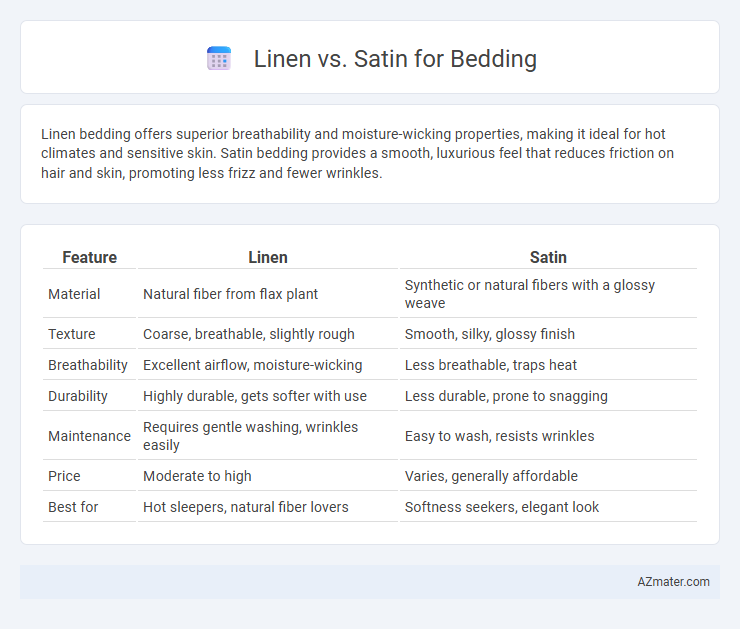Linen bedding offers superior breathability and moisture-wicking properties, making it ideal for hot climates and sensitive skin. Satin bedding provides a smooth, luxurious feel that reduces friction on hair and skin, promoting less frizz and fewer wrinkles.
Table of Comparison
| Feature | Linen | Satin |
|---|---|---|
| Material | Natural fiber from flax plant | Synthetic or natural fibers with a glossy weave |
| Texture | Coarse, breathable, slightly rough | Smooth, silky, glossy finish |
| Breathability | Excellent airflow, moisture-wicking | Less breathable, traps heat |
| Durability | Highly durable, gets softer with use | Less durable, prone to snagging |
| Maintenance | Requires gentle washing, wrinkles easily | Easy to wash, resists wrinkles |
| Price | Moderate to high | Varies, generally affordable |
| Best for | Hot sleepers, natural fiber lovers | Softness seekers, elegant look |
Introduction: Linen vs Satin Bedding
Linen bedding offers exceptional breathability and moisture-wicking properties, making it ideal for warm climates and those seeking durability and natural texture. Satin bedding provides a smooth, glossy surface that reduces friction on skin and hair, enhancing comfort and luxury while maintaining a cooler feel. Choosing between linen and satin depends on priorities such as temperature regulation, tactile experience, and maintenance preferences.
Material Composition and Origins
Linen is made from flax fibers, known for its breathability, durability, and natural moisture-wicking properties, originating from ancient Europe and Egypt. Satin, typically crafted from silk, polyester, or nylon fibers, offers a smooth, glossy finish achieved through a specific weave rather than a fiber type, with historical roots in China. The material composition directly influences the texture, temperature regulation, and maintenance requirements of bedding options.
Texture and Feel Comparison
Linen bedding offers a breathable, slightly coarse texture that softens over time, providing a natural, relaxed feel ideal for warm climates. Satin bedding features a smooth, glossy surface with a silky touch that creates a luxurious and cool sensation, perfect for those seeking elegance and softness. The key difference lies in linen's textured durability versus satin's sleek, slippery finish, influencing personal comfort preferences and bedroom aesthetics.
Breathability and Temperature Regulation
Linen bedding excels in breathability due to its natural flax fibers, which allow superior air circulation and moisture-wicking, making it ideal for hot sleepers and warm climates. Satin, typically made from synthetic fibers or silk, offers a smooth finish but lacks the same moisture-wicking properties, often trapping heat and causing discomfort during warm nights. Choosing linen over satin enhances temperature regulation and keeps the sleeper cool and dry throughout the night.
Durability and Longevity
Linen bedding is renowned for its exceptional durability, thanks to flax fibers that become softer and stronger with each wash, often lasting for decades. Satin, typically made from silk or polyester, offers a smooth and luxurious feel but tends to wear out faster, showing signs of pilling or fraying over time. Investing in linen ensures long-term resilience and sustained comfort, while satin provides short-term elegance with less durability.
Maintenance and Care Requirements
Linen bedding demands gentle care, including washing in cold water and air drying to maintain its natural fibers and prevent shrinkage. Satin bedding requires delicate handling, typically machine washed on a gentle cycle with mild detergent and air drying or low-heat tumble drying to preserve its smooth texture and sheen. Both fabrics benefit from avoiding bleach and ironing at low temperatures to extend their lifespan and retain their appearance.
Hypoallergenic Properties
Linen bedding is highly valued for its natural hypoallergenic properties, making it an excellent choice for allergy sufferers as it resists dust mites, mold, and bacteria. Satin, often made from synthetic fibers, lacks these natural breathability and moisture-wicking abilities, which can increase allergen accumulation. Choosing linen for bedding supports better skin health and reduces the risk of allergic reactions due to its organic fiber composition and enhanced airflow.
Aesthetic Appeal and Design Options
Linen bedding offers a natural, textured aesthetic with a matte finish that complements rustic, bohemian, and minimalist design styles, enhancing a cozy and breathable bedroom atmosphere. Satin bedding provides a sleek, glossy surface that reflects light beautifully, creating a luxurious and elegant appearance ideal for modern, glamorous, and sophisticated interiors. Both materials offer diverse color palettes and patterns, but satin is often favored for its smooth sheen and vibrant hues, while linen's organic look suits earthy tones and subtle, timeless designs.
Cost and Value for Money
Linen bedding typically costs more upfront due to its natural fibers and durability, offering excellent value for money through long-lasting quality and breathability. Satin bedding is generally more affordable but may wear out faster and provide less breathability, making it less cost-effective over time. Choosing linen ensures a higher initial investment but better return through longevity and comfort.
Which Bedding is Best for You?
Linen bedding offers superior breathability and moisture-wicking properties, making it ideal for hot sleepers and those seeking natural, hypoallergenic materials. Satin bedding, with its smooth, silky texture, reduces friction on skin and hair, providing a luxurious feel preferred by individuals focused on skin and hair care. Choosing between linen and satin depends on whether you prioritize temperature regulation and durability or softness and aesthetic appeal in your bedding.

Infographic: Linen vs Satin for Bedding
 azmater.com
azmater.com